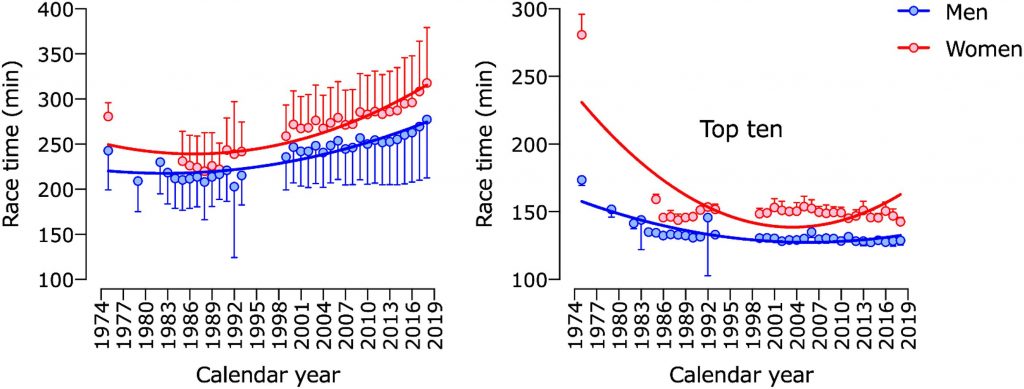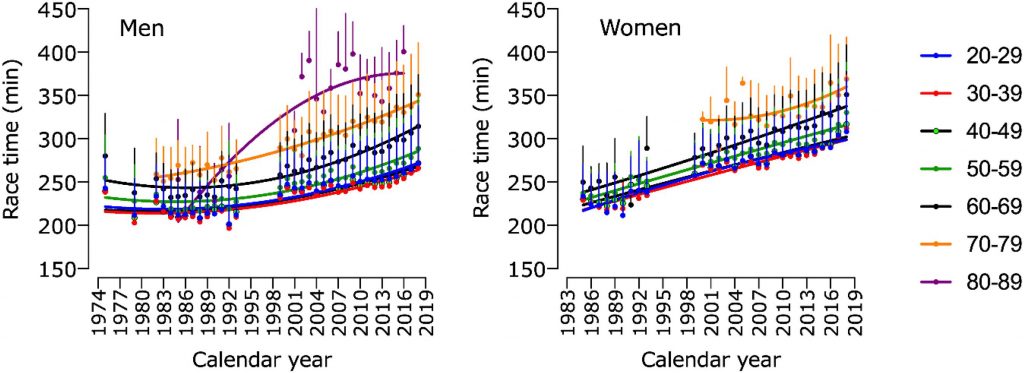The Berlin Marathon is considered the fastest marathon in the world. In a study, in which the Swiss top cyclist Marlen Reusser (silver medal at the Olympic Games in Tokyo) also participated, the Berlin Marathon was examined for trends regarding participation and performance. We have summarized the results for you.
Number of participants
When the “Berlin People’s Marathon” was first held in 1974, only 236 men and 8 women took part. In 2018, on the other hand, there were already 28,373 men and 12,268 women. It is striking that the increase in participation in recent years is significantly higher among women compared to their male counterparts. The ratio between the sexes is therefore becoming more and more balanced at the Berlin Marathon (but is still clearly unbalanced at the moment).
The gender distribution at the Berlin Marathon does not reflect the status quo in relation to the distribution of all race starts (over all distances) worldwide, where the ratio is very balanced according to an American study. According to the same study, the shorter the running distance, the higher the number of starts for women in relation to male participation.
It is also interesting that the ratio between men and women is significantly more balanced among younger participants than is the case in older age categories. This is not least due to the fact that female athletes have historically faced obstacles that have made participation more difficult.

Table: Number of participants in the “Berlin Marathon” from 1974 to 2019 by gender and age group.
Performances
In addition to the number of participants, the study also analyzed finisher times (top 10 times / average of age categories).
It is striking that the top 10 times in all age categories have become increasingly faster over the years. Several factors seem to be decisive in this development. Not least, significant progress has been made in the areas of training theory, race preparation, nutrition, race nutrition and equipment. The development of running shoes alone has had a significant impact on the times of the top 10 athletes over the past 4 years.

Table: Running times of men and women at the “Berlin Marathon” over the calendar years.
Not surprisingly, the increasing number of participants leads to slower average times in the different age categories. While in earlier years and with fewer athletes participating, more elite runners took part in the Berlin Marathon, the starting field is shifting more and more towards mass sports, which has a direct impact on the times run.

Table: Running times of men and women at the Berlin Marathon in the age groups over the calendar years.
Marathon and running.COACH
We at running.COACH are aware of the development that especially marathons attract more and more grassroots athletes. We hope that our training plans will be able to push this development even further, because especially for long distances it seems important to us to be able to stand well prepared at the starting line.
The fact that training theory, race preparation and nutrition are among the important factors why the times of top athletes are getting faster and faster, confirms us in our work. Because we see it as our most important task to support the running.COACH community with our plans and our content in the mentioned areas and to be able to convey our knowledge in the best way.
In any case, we wish all of the 172 running.COACH users at the start a lot of fun – let’s stop the trend with the slowing down times together 😉

